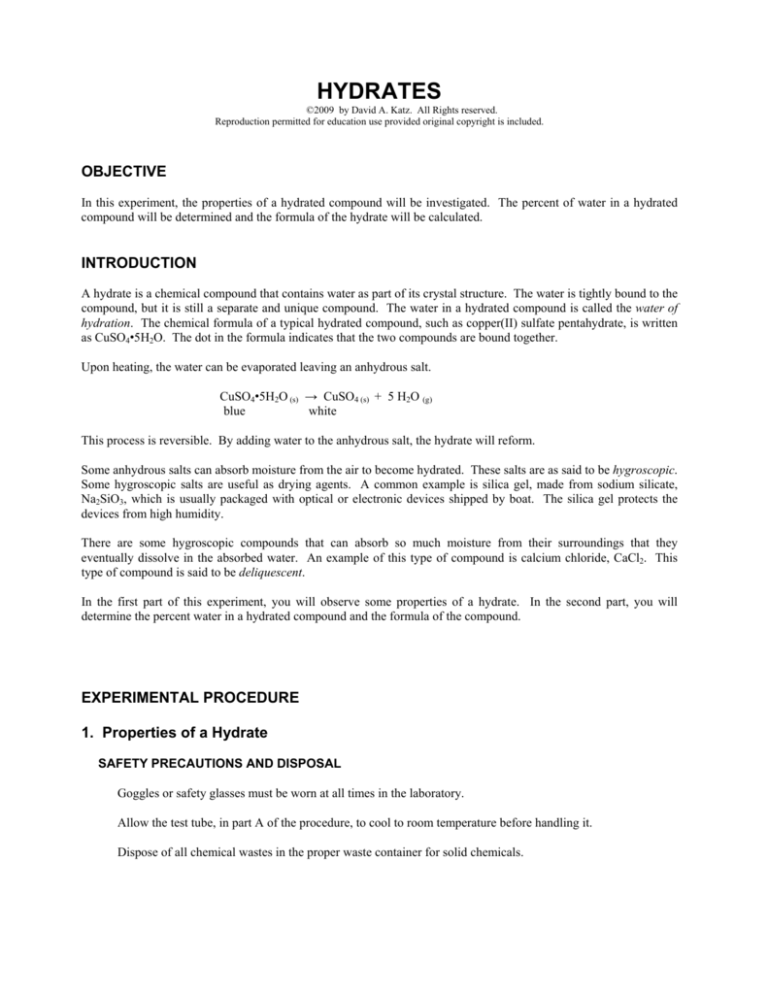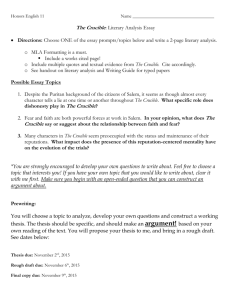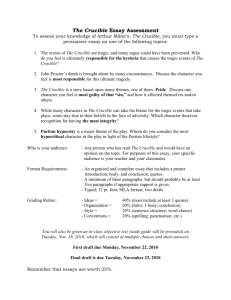
HYDRATES
©2009 by David A. Katz. All Rights reserved.
Reproduction permitted for education use provided original copyright is included.
OBJECTIVE
In this experiment, the properties of a hydrated compound will be investigated. The percent of water in a hydrated
compound will be determined and the formula of the hydrate will be calculated.
INTRODUCTION
A hydrate is a chemical compound that contains water as part of its crystal structure. The water is tightly bound to the
compound, but it is still a separate and unique compound. The water in a hydrated compound is called the water of
hydration. The chemical formula of a typical hydrated compound, such as copper(II) sulfate pentahydrate, is written
as CuSO4•5H2O. The dot in the formula indicates that the two compounds are bound together.
Upon heating, the water can be evaporated leaving an anhydrous salt.
CuSO4•5H2O (s) → CuSO4 (s) + 5 H2O (g)
blue
white
This process is reversible. By adding water to the anhydrous salt, the hydrate will reform.
Some anhydrous salts can absorb moisture from the air to become hydrated. These salts are as said to be hygroscopic.
Some hygroscopic salts are useful as drying agents. A common example is silica gel, made from sodium silicate,
Na2SiO3, which is usually packaged with optical or electronic devices shipped by boat. The silica gel protects the
devices from high humidity.
There are some hygroscopic compounds that can absorb so much moisture from their surroundings that they
eventually dissolve in the absorbed water. An example of this type of compound is calcium chloride, CaCl2. This
type of compound is said to be deliquescent.
In the first part of this experiment, you will observe some properties of a hydrate. In the second part, you will
determine the percent water in a hydrated compound and the formula of the compound.
EXPERIMENTAL PROCEDURE
1. Properties of a Hydrate
SAFETY PRECAUTIONS AND DISPOSAL
Goggles or safety glasses must be worn at all times in the laboratory.
Allow the test tube, in part A of the procedure, to cool to room temperature before handling it.
Dispose of all chemical wastes in the proper waste container for solid chemicals.
Materials needed:
Cobalt(II) chloride hexahydrate, CoCl2•6H2O
Calcium chloride, CaCl2, anhydrous
Test tube,
Test tube holder
Spatula or scoopula
Small watch glass
Glass stirring rod
20-mL or 50-mL beaker
600-mL or 1000-mL beaker
Procedure:
A. Behavior of a Hydrate
1.
Place a few crystals of cobalt(II) chloride hexahydrate into a clean, dry test tube. Hold the test tube at
an angle, heat the bottom of test tube gently in a Bunsen burner flame for about 1 to 2 minutes. Record
your observations.
2.
Allow the test tube to cool to room temperature. Hold the bottom of the test tube with your hand. Add
two or three drops of water to the test tube. Record your observations.
B. Properties of Anhydrous CaCl2
1.
Place a few beads of anhydrous calcium chloride on a watch glass. Observe the compound’s
appearance.
2.
Set the watch glass aside until the end of the remainder of experiment. NOTE: For dry environments,
where the relative humidity is less than 20%, follow the procedure below:
Fill a small beaker, 20-mL or 50-mL, approximately half-way with water. Place it next to the watch
glass containing the calcium chloride. Cover the watch glass and the beaker with a large, inverted,
600-mL or 1000-mL beaker. Allow the material to stand, undisturbed until the end of the
experiment.
3.
At the end of the experiment, examine the calcium chloride. Touch it with your stirring rod. Record
your observations.
2. Determination of the Percentage of Water in a Hydrate
SAFETY PRECAUTIONS AND DISPOSAL
Goggles or safety glasses must be worn at all times in the laboratory.
The crucible will become very hot in this procedure. Allow the crucible to cool before handling. Use crucible
tongs to hold the crucible.
Dispose of the anhydrous salt in the waste chemical container at the end of the experiment.
2
Materials needed:
An “unknown” hydrate salt:
BaCl2•xH2O
MgSO4•xH2O
Na2CrO4•xH2O
Crucible and cover
Clay triangle
Crucible tongs
Procedure:
1. Prepare the crucible
If necessary, clean and dry the crucible and cover.
Place the crucible and cover on a clay triangle, supported on an iron
ring (See Figure 1). Heat the crucible gently for about one minute,
then heat strongly for about 5 minutes. Allow the crucible and cover
to cool. Handle the hot or cooled crucible and cover using your
crucible tongs. (See Figure 2)
Weigh the cooled crucible and cover and record the mass to 0.001 g.
Weigh the cover of the crucible separately, and record its mass. (This
second step will allow you to still determine your final results if the
crucible cover falls off the crucible and breaks during the experiment.)
2.
Figure 1. Heating a crucible
Weigh 1.00 to 1.500 g of your unknown hydrate. Place the hydrate into the crucible and weigh the
crucible, cover, and hydrate together. Record the mass to 0.001 g.
3. Place the crucible and its contents on a clay triangle. Adjust the
lid on the crucible so it is slightly ajar. Heat gently with a
Bunsen burner for one minute. Continue to heat with a
moderate flame for 5 minutes. Increase the heat to high and
heat for an additional 5 minutes - the bottom of the crucible
will glow with a red color. Allow the crucible to cool.
4. When the crucible is cool, close the lid and weigh the crucible,
cover, and its contents. Record the mass to 0.001 g. Save the
crucible and contents until you have completed your
calculations for the experiment.
Figure 2. Using crucible tongs to
hold a crucible.
5. After completing the calculations, inspect the compound inside the crucible. Use your crucible tongs or a
glass stirring rod to press down on the compound. How does it differ from the original sample of the
hydrate? What happens if you add one or two drops of water to the residue in the crucible?
Reference
Weiner, Susan A. and Edward I. Peters, Introduction to Chemical Principles, A Laboratory Approach, 3rd
Edition, Saunders College Publishing, 1986.
3
HYDRATES
Name________________________________________
Course/Section ____________________________
Partner’s Name (If applicable) _________________________________________
Date __________________
DATA AND RESULTS
1. Properties of a Hydrate
A. Behavior of a Hydrate
What did you observe upon heating the hydrate in the test tube?
What did you observe when water was added to the anhydrous salt in the test tube?
B. Properties of Anhydrous CaCl2
Describe the initial appearance of the anhydrous calcium chloride.
Describe the appearance of the calcium chloride at the end of the experiment.
2. Determination of the Percentage of Water in a Hydrate
Which unknown hydrate are you using? ___________________
Mass of crucible and cover
_______________ g
Mass of crucible, cover, and hydrate
_______________ g
Mass of crucible, cover, and anhydrous compound after heating
_______________ g
4
Calculations
Mass of hydrate used
_______________ g
Mass of anhydrous compound (at end of the experiment)
_______________ g
Mass of the water of hydration
_______________ g
Calculate the percent of water in your hydrate (show your properly
labeled set-up below)
_______________ %
Moles of anhydrous compound (show properly labeled set-up below)
_______________ mole
Moles of water of hydration (show properly labeled set-up below)
_______________ mole
Ratio:
moles water of hydration
(show properly labeled set-up below)
moles anhydrous compound
What is the formula of your hydrated compound?
_______________
______________________
What changes did you observe in your unknown hydrate?
5








